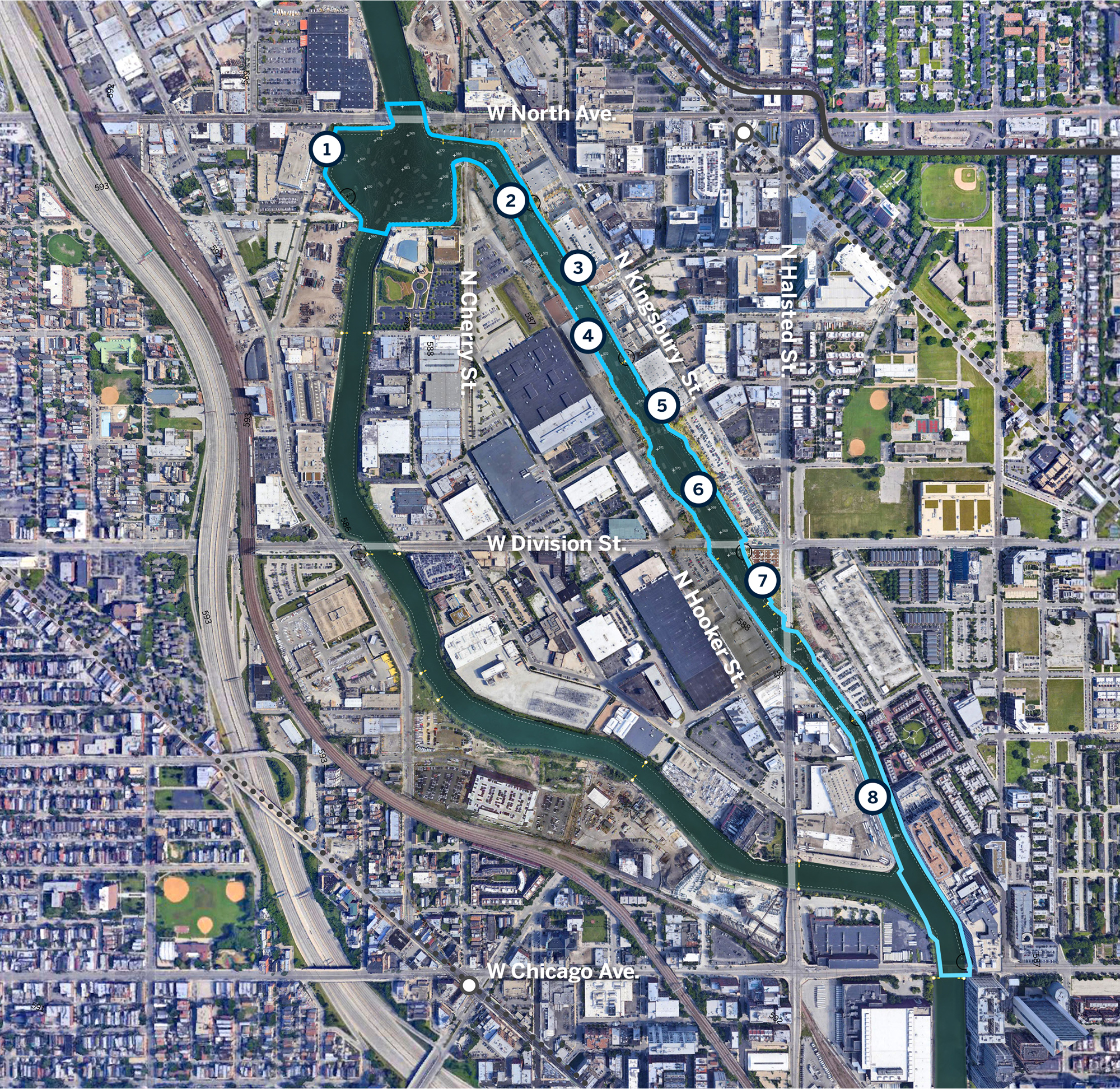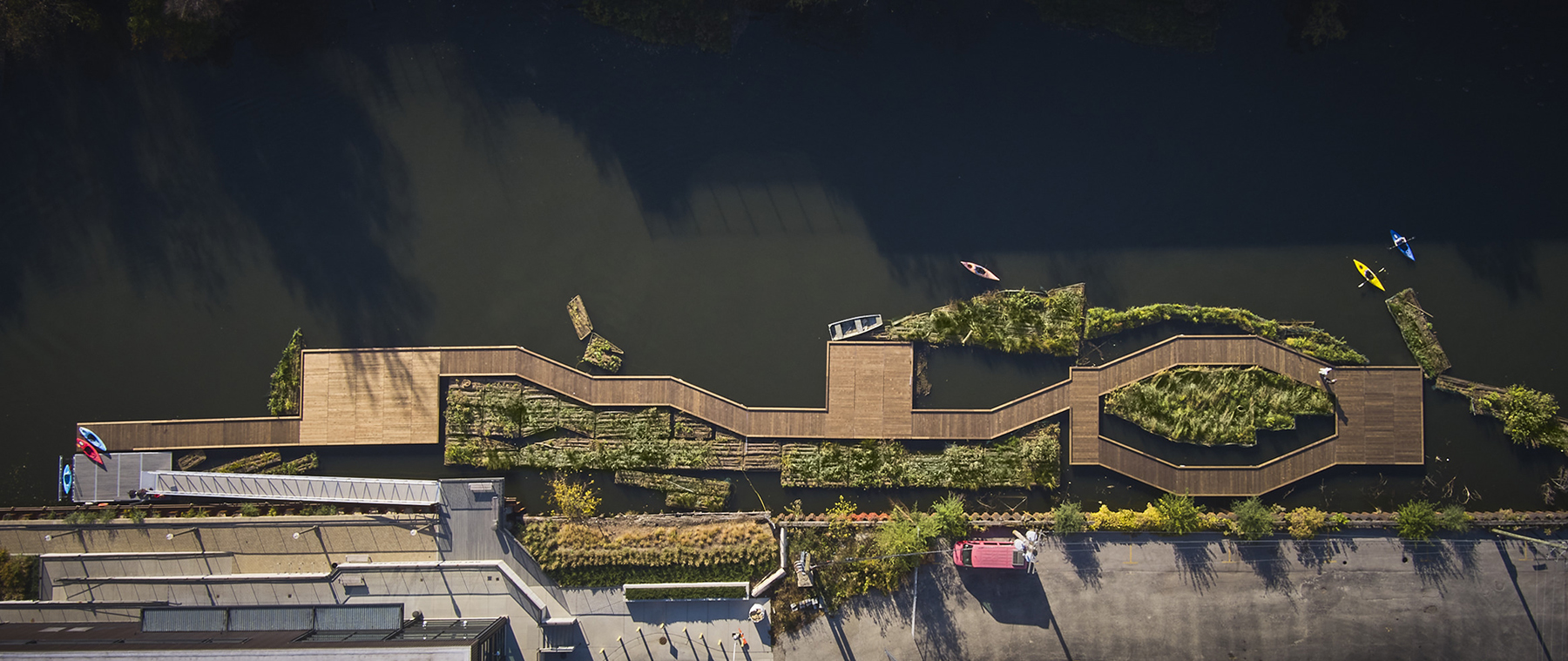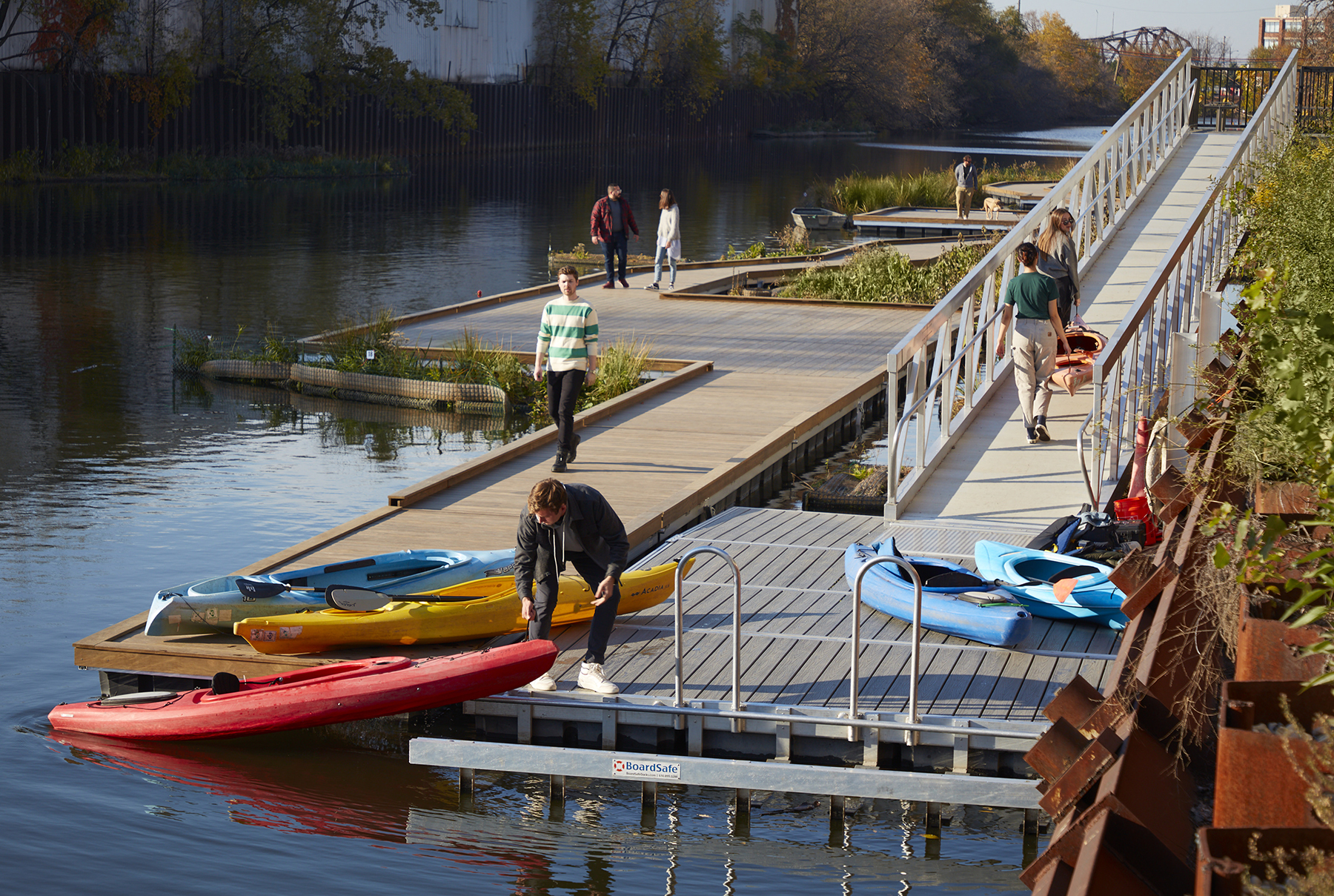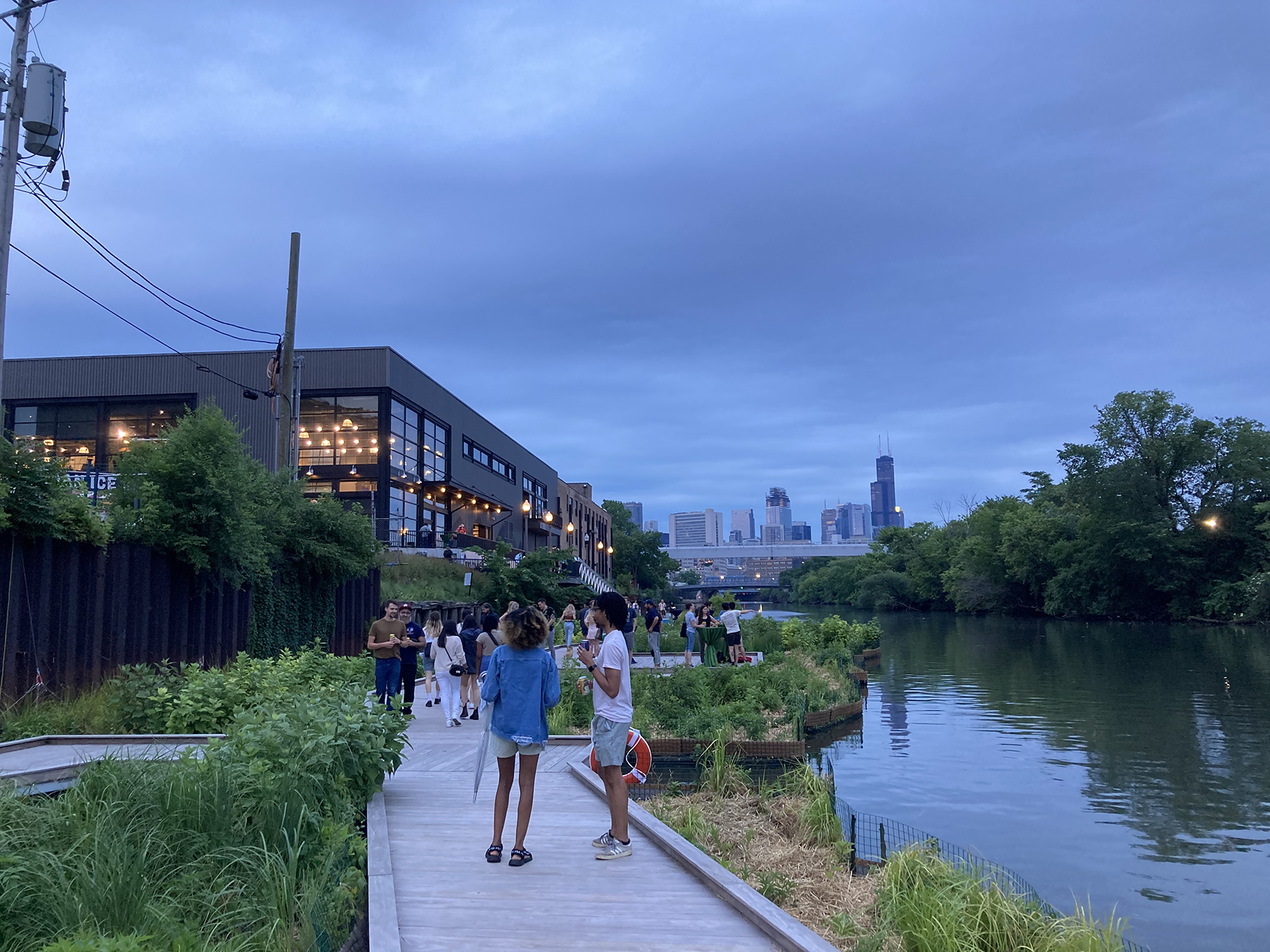By Leslie Nemo
Piece by piece, a floating park is materializing in a Chicago River canal. The aptly named Wild Mile will fill both shorelines of the North Branch Canal — a waterway edged with concrete, wood, or sheet pile that extends roughly parallel to Lake Michigan in downtown Chicago — with floating flora and fauna habitat that visitors can meander through on accompanying floating boardwalks.

First pursued in the 2010s by Urban Rivers, a nonprofit formed by ecologists looking to improve water habitats in the city, the floating habitat tactic blossomed into a project partially guided by the Chicago Department of Planning and Development. Urban Rivers has already spent about $2 million on 800 linear ft of floating garden and 400 linear ft of walkway, along with a kayak launch and a platform for hosting classes. Remaining progress will be piecemeal as canal edge property owners who wish to do so contribute to the project and as Urban Rivers receives funding, whether by donations, grants, or local partnerships.
Ultimately, “we want it to be wildlife first, meaning we want to make sure that what we’re doing has a positive impact on the ecosystem and the habitat. That is kind of our North Star,” says Nick Wesley, the director of Urban Rivers. The guiding principle led to a framework plan that calls for welcoming people to a park that serves humans as well as it serves wildlife.
Dug in 1857 by former Chicago Mayor William Ogden as his company excavated a clay deposit for material to make bricks, the fairly straight North Branch Canal attracted industry to Goose Island — the sliver of land left between the digging and the Chicago River itself. The U.S. Army Corps of Engineers has controlled the waterway since 1896 and still oversees the canal despite commercial shipping on it being almost nonexistent since 1959. In recent decades, the fate of the canal has been cemented: Drawbridges crossing the channel no longer function or are being transformed to fixed designs, keeping commercial boats from using the water.

It was into this semi-obsolete waterway that Urban Rivers first started slipping plant rafts in 2016. To improve water quality and attract wildlife, the organization opted for floating structures carrying native plants that would mimic natural shorelines.
The canal side walls, which are mostly concrete, wood, or sheet pile, offer a blunt transition from land to water. The floating foliage intends to introduce the intermediary zones that real rivers have — spaces where land grows increasingly marshlike and is inundated until the habitat becomes fully aquatic. Plants take in and produce nutrients while generating oxygen, changes that could make for a healthier environment and create the physical conditions appealing to native birds, insects, amphibians, and more.
The survival of Urban Rivers’ early installations in the canal attracted attention from local community groups and city government. In 2017, the planning and development department sought to guide the “rewilding” of the milelong canal stretch. The winner of the request for proposals process to become the lead designer on the master plan — Skidmore, Owings & Merrill, an architectural, urban planning, and engineering firm — helped Urban Rivers deploy its 2016 installations, says Doug Voigt, AIA, AICP, an urban design and planning partner with SOM.
“Right away, we saw the potential in terms of its replicability and scalability,” Voigt says, as well as how the project could become embedded with surrounding communities. The SOM team took this possibility seriously by organizing public meetings about the project and factoring feedback into the design.
Floating a framework
The collaborations ended with a framework plan that made space for habitat, activity, and recreation.

The southern portion, which includes more residential properties and has a city-owned tract of land, could offer an education center and lookout area. Farther north — and where most Wild Mile work has been completed so far — larger commercial presences like REI and Whole Foods plan to host pedestrian and Americans with Disabilities Act-accessible paths along with habitat and art installations. In some areas, the paths by FWM Docks will bump out into platforms elevated for viewing or widened to host seating and small classes. In the turning basin at the end of the canal, the plan calls for the installation of perimeter plant life. Dedicated space for performances and art installations will leave enough open water for kayakers and other recreational boaters.

The choice to continue building habitat space via floating platforms like the ones Urban Rivers installed earlier came in part from kayak trips that Omni Ecosystems, the landscape architect on the framework plan, took through the canal. “We were really thinking critically about how we could bring that ecotone back into the equation and bridge water and land,” says Michael Skowlund, PLA, LEED AP, the company’s director of landscape architecture. “We were trying to make space.”
Rafts of coconut coir produced by Scottish company Biomatrix Water will float in the canal, tethered by Hazelett Marine elasticized anchors so the installations move up and down with the water as volumes change throughout the year. Amongst the plant beds will be more insertions to tempt wildlife: logs for turtles to rest on, for example, and wall planters to carry greenery needing less water. The modular approach of inserting floating plant beds complements the expansion of the riverwalk running along the canal. An easement requires new property development along the canal edge to sit 30 ft back from the top of the bank. The rule will allow the city riverwalk to grow incrementally as redevelopment occurs — a method the Wild Mile floating designs can match, Skowlund says.
Permission to (expand) land
For any of the proposed plans, the project needed buy-in from stakeholders controlling the canal and its edges. Though the Army Corps hasn’t regularly maintained the canal in decades, the project had to pursue a 408 permit from the federal agency, which ensured that the plans wouldn’t interfere with the intended purpose of the canal. The Wild Mile now has permission to extend 50 ft into the water.
Bordering property owners also had to agree to contribute. One of these groups, Waste Management of Illinois Inc., occupies about a quarter-mile of shoreline that is mostly without the sheet piling that edges other sections of the canal. With a relatively bare edge on a piece of property not open to the public, the plan is to build out a fixed — rather than floating — habitat area, says Chris Rubak, P.E., a senior engineering manager with WM.
A rock revetment will extend from the canal edge to host native plants, says Tim Pollowy, PLA, ASLA, a senior landscape architect with Hey and Associates Inc., a Midwest-based engineering and ecological consulting group working on the WM property. Remaining retaining wall fragments will stay in place while sections that have collapsed underwater could be good for hosting mussels; Urban Rivers has been working with the Forest Preserve District of DuPage County on captive breeding of the bivalves. “It’s more to be seen by people but used by fish, wildlife, turtles, birds, pollinators, and beavers,” Pollowy says. “We’ve got a lot of beaver chews on this property.” As the permitting process just began, WM anticipates construction to wrap up in about three years.
As the project grows, Urban Rivers will ensure the primary goals — habitat creation and healthy biodiversity — are met. The organization has been working with the Shedd Aquarium and Metropolitan Water Reclamation District of Greater Chicago on water and wildlife surveys as well as sampling the water for macroinvertebrates that indicate what the water quality is like, Wesley says.

Some of the community groups that have contributed to the Wild Mile so far will help too. The advocacy group Friends of the Chicago River is building a geographic information systems database on land ownership, habitat quality, pollution levels, and access points in the river, and Current, a clean water research group, launched H2NOW Chicago, a real-time water quality assessment system, in 2021. The parties have held a few workshops on possible data sharing, Voigt says.
Urban Rivers plans to install another 400 ft of walkway funded by $1.76 million from city open space impact fees, or payments collected from developers for the sake of creating public gathering places. The organization has also kept busy with other work in the city. Team members are working on installing more floating habitat in Bubbly Creek near the Shedd Aquarium. The SOM group has also expanded the reach of the Wild Mile by investigating whether similar design ideas could work for other firm projects in Austin, Texas, and Guangzhou, China.
By pushing for wildlife habitat first, the Wild Mile and similar projects perhaps counterintuitively make for a better human experience too. “You could make something look nice but have not too much ecological benefit, and most people will still see it and it'll be good,” Wesley says. “But you're not going to get that moment where something completely unexpected and wild happens.”



